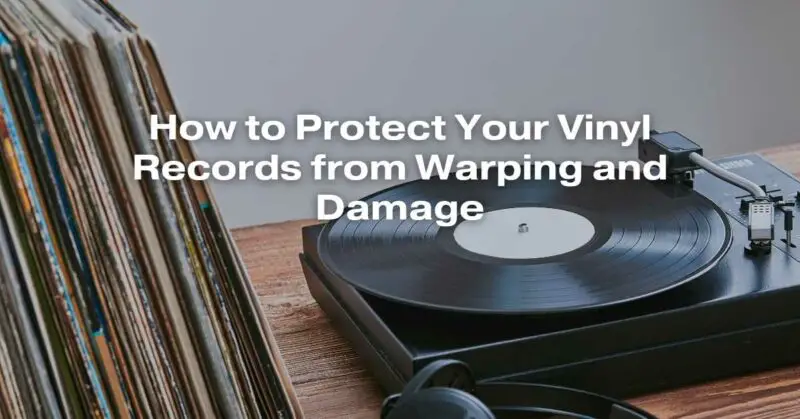Vinyl records, once considered a relic of the past, have experienced a remarkable resurgence in popularity over the last few decades. Audiophiles and music enthusiasts alike have rediscovered the warm, analog sound that vinyl records provide. However, vinyl records are delicate and can easily warp or become damaged if not properly cared for. In this comprehensive guide, we will explore the best practices to protect your vinyl records from warping and damage, ensuring that your cherished collection stands the test of time.
Understanding Vinyl Record Warping
Before diving into protection methods, it’s important to understand what causes vinyl records to warp in the first place. Vinyl records are made from a combination of plastic materials, most commonly polyvinyl chloride (PVC). Warping occurs when the record becomes deformed due to exposure to unfavorable conditions, primarily heat and pressure. Here are the main causes of vinyl record warping:
- Heat: Excessive heat can soften the vinyl, causing it to warp when subjected to pressure, such as the weight of other records or improper storage.
- Direct Sunlight: Prolonged exposure to direct sunlight can cause the vinyl to heat up rapidly and warp.
- Storage Position: Storing records upright with a slight lean can prevent warping by distributing the weight more evenly.
- Moisture: High humidity levels can lead to mold growth on records and even damage the grooves, affecting playback.
- Poor Handling: Mishandling records, such as dropping them or improperly placing the needle on the turntable, can also lead to warping and damage.
Now that we understand the causes of warping, let’s explore how to protect your vinyl records effectively.
Protecting Your Vinyl Records
1. Proper Storage
Proper storage is crucial in preventing vinyl records from warping and sustaining damage. Here are some guidelines to follow:
- Vertical Storage: Store your records vertically, like books on a shelf. This prevents excessive pressure on the records and minimizes the risk of warping.
- Sturdy Shelving: Invest in sturdy, well-built record shelving units designed to hold vinyl records. Avoid stacking records horizontally.
- Room Temperature: Maintain a consistent room temperature between 65-70°F (18-21°C). Extremes in temperature can cause warping.
- Avoid Direct Sunlight: Keep your records away from direct sunlight and sources of heat, such as radiators or space heaters.
- Use Plastic Sleeves: Keep your records in anti-static polythene or polypropylene sleeves to protect them from dust and static buildup.
2. Proper Handling
Handle your vinyl records with care to prevent scratches, scuffs, and warping:
- Clean Hands: Always wash your hands before handling records to avoid transferring oils and dirt to the surface.
- Hold the Edges: Handle records by their edges, avoiding contact with the grooves and labels.
- Use a Dust Brush: Before playing a record, use a carbon fiber or anti-static brush to remove dust and debris from the surface.
- Proper Turntable Setup: Ensure your turntable is properly calibrated, and the stylus is in good condition to avoid causing damage during playback.
3. Cleaning Your Records
Regular cleaning is essential to maintain the integrity of your vinyl records. Here’s how to do it:
- Record Cleaning Brush: Invest in a good quality record cleaning brush to remove dust and static.
- Vinyl Cleaning Solution: Use a dedicated vinyl record cleaning solution and a microfiber cloth to clean the surface gently.
- Vinyl Cleaning Machines: For serious collectors, consider using a vinyl cleaning machine that can deep-clean records.
4. Outer Sleeves and Inner Sleeves
Protective outer sleeves and inner sleeves are vital for vinyl record preservation:
- Outer Sleeves: Invest in clear polythene or polypropylene outer sleeves to protect the record jacket from dust and wear.
- Inner Sleeves: Replace original paper inner sleeves with anti-static or poly-lined inner sleeves to prevent scratches and static buildup.
5. Storage Accessories
Consider using the following accessories to enhance your vinyl record protection:
- Record Weights: Placing a record weight or puck on the turntable spindle can help reduce vibrations and prevent warping during playback.
- Clamp or Stabilizer: A record clamp or stabilizer can improve sound quality and reduce the risk of warping.
6. Periodic Inspections
Regularly inspect your vinyl records for signs of wear, damage, or warping. If you notice any issues, take corrective action immediately to prevent further deterioration.
Conclusion
Vinyl records offer a unique and timeless listening experience, but their delicate nature requires careful attention to preservation. By following these comprehensive guidelines for protecting your vinyl records from warping and damage, you can ensure that your cherished collection remains in pristine condition for years to come. Remember that proper storage, handling, cleaning, and the use of protective accessories are key to safeguarding your vinyl treasures and enjoying their warm, analog sound for generations to come.


